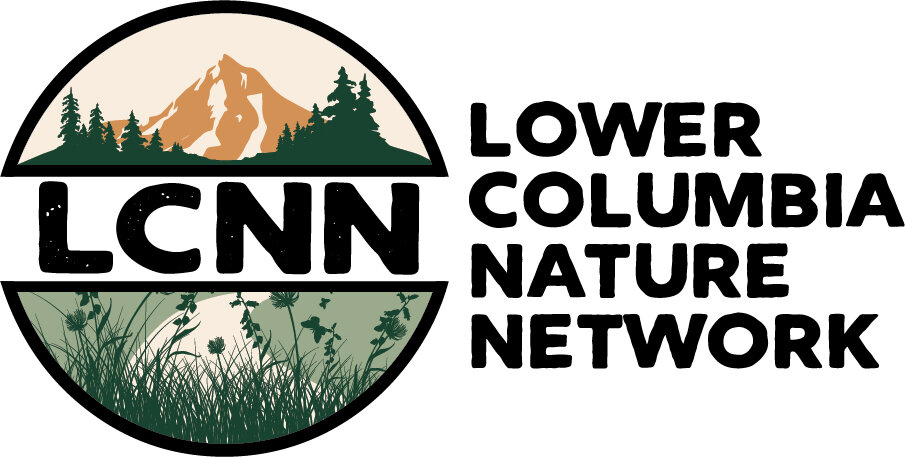The Power of Collaboration
This post was co-written by the Lower Columbia Nature Network and U. S. Fish and Wildlife Service.
The Lower Columbia Nature Network (LCNN), formerly the Clark County Nature Network, began over five years ago as a collection of organizations committed to increasing opportunities and reducing barriers for youth and families to experience nature. To read all about how it got started, check out Lower Columbia Nature Network – What is it? How did it start? What’s ahead in the future?
What began as a special project of The Intertwine Alliance, transitioned to a volunteer-led coalition, when the need for a focus on Clark County was identified. The Portland based Intertwine Alliance needed further support with leading this localized effort, and while enthusiasm for the group was retained, the coalition lacked funds to further the work. As a result, the potential of this group has progressed slowly these last few years, often stalling without an operating budget or clear direction. The consensus kept coming back to the same questions:
Is it practical for this coalition to grow and continue to be volunteer-led?
How can we as a coalition provide better information to the community if our individual organization’s websites limit us?
How can we as partners share content and resources with each other when our websites and distribution abilities are limited?
What is the direction of this group and how does it help me reach a more diverse community?
How can we generate funds to advance this work if to apply for a grant we need to be a formal organization/agency ?
With Jane Tesner Kleiner, as a volunteer-lead, but no organization behind her to support expansion, the group dreamed of the possibilities, but struggled to advance many of the ideas generated. This left members wondering about the benefit of the coalition and left community needs unmet.
Needs Identified:
Since the beginning, the U. S. Fish and Wildlife Service (the Service) through various programs, stayed actively engaged in the group over the years. However, in 2019 Service staff at Ridgefield National Wildlife Refuge Complex (RNWRC), realized the power of this partnership couldn’t be reached without funding to help strategically move the group forward. RNWRC in alignment with the Service’s Portland-Vancouver Urban Refuge Program, is actively working to reduce barriers for youth and families to access nature. It became clear that partnering more deeply and growing their support of the LCNN, was a good fit.
“The coalition brings so many together to do the work we are all passionate about – connecting our communities to the outdoors. With capacity limited across organizations, various operating budgets and diverse skillsets and knowledge, it has always made sense to me that together we could do more for the community. However, it started to not add up that the cost of leading the coalition and energy put towards, was reliant on Jane as a single volunteer. Her potential as a lead, and work the group was able to achieve was stifled by Jane having to operate the coalition on her own time and at her own expense. So the Service worked to see what we might do to advance the good work and better support Jane as that lead.””
The Service has entered into a partnership with the LCNN to help amplify the work of the coalition, share resources and ideas among partners and work to provide safe and equitable access to the outdoors. Ultimately the goal is to increase community awareness of opportunities to connect with nature, nearby and in their own backyards.
Growing together:
In October 2020, the Service was able to provide funding that allowed the Friends of Ridgefield National Wildlife Refuge and Vancouver-based consultants Jane Tesner Kleiner, Michelle Sanow , and Deviant Compassion Consulting, to work together in partnership with the Service to elevate the coalition and move it in a more cohesive and efficient direction. Over the summer of 2021 the consultants engaged the larger group of partners to identify some directional changes for the coalition. After listening to input from the group, the relaunch of the coalition included a name change to the Lower Columbia Nature Network to better reflect the communities we hope to engage in this work. A new brand identity was created to showcase the broader region the group supports and the idea that a connection to nature can be both nearby and diverse in ways people engage.
Additionally in 2021, the following updates and organizational structure were made to help enhance the coalition:
• Updated logo creation
• Branding kit
• Website
• Partnership mapping
• Communications plan
• Email marketing system
• Projected five-year work plan
• Literature review
The LCNN, has also been selected to join the Cities Connecting Children to Nature 26 month cohort, which will help advance the work even further in the years to come.
Moving Forward:
Part of the five-year work plan, developed over the summer of 2021, is an investigational study to determine what model is best for the Lower Columbia Nature Network and ensure long-term success. For 2022, Ridgefield NWRC has again committed to this partnership to both help strengthen as well as participate alongside the other important members of the organization. As we work together to relaunch the group and raise awareness of it, we will also work to assess community needs and explore nonprofit status, to help determine if that is the best course for this group.
While additional funding will be needed to expand these efforts, the support through the U.S. Fish and Wildlife Service has been a great start to building capacity long term. We look forward to other opportunities as a result of the work we’ve been able to accomplish. We are grateful for the power of collaboration and the belief our partners have in the Lower Columbia Nature Network. We are more effective and can better reduce barriers for families to access nature when we work together.

